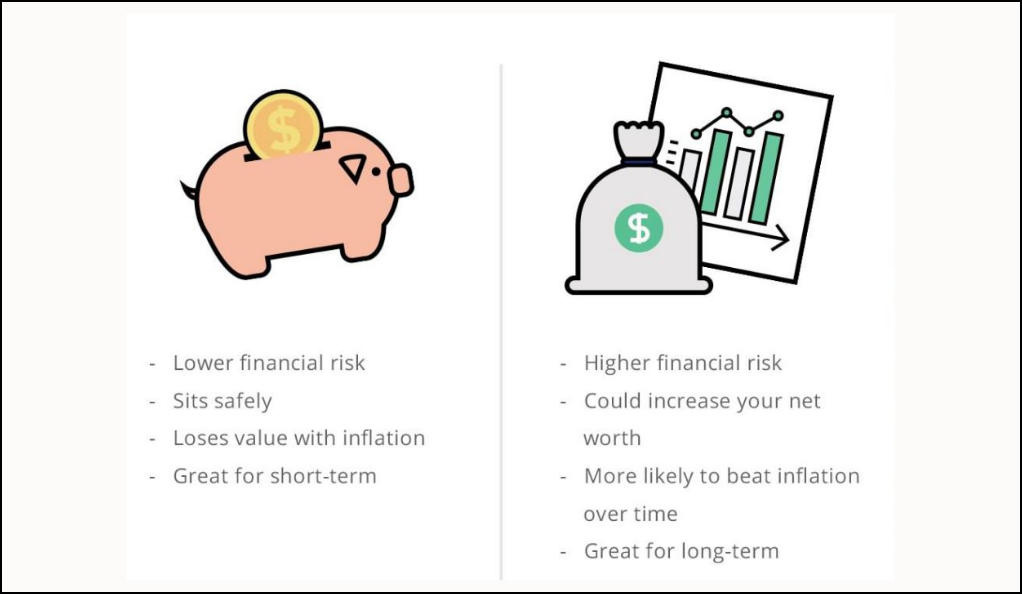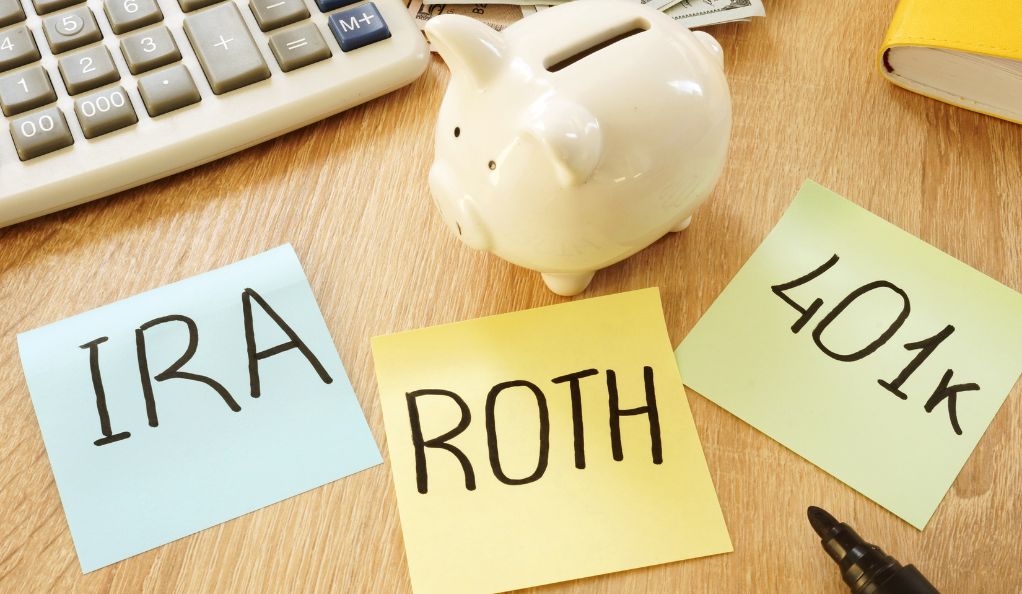Introduction
In the world of personal finance, there exists a pervasive myth that saving and investing are interchangeable concepts, two sides of the same coin. However, this couldn’t be further from the truth. Saving and investing are distinct financial strategies, each with its own set of characteristics, benefits, and considerations. In this comprehensive guide, we will unravel the myth surrounding saving and investing, delving deep into their fundamental differences, and shedding light on their respective roles in achieving financial goals.

Understanding the Basics
What is Saving?
At its core, saving involves setting aside a portion of one’s income with the intention of preserving it for future use. This financial practice is characterized by its safety and predictability. Savings are typically held in easily accessible accounts such as savings accounts, certificates of deposit (CDs), and money market accounts. These accounts offer modest interest rates, ensuring that the principal amount remains intact while earning a nominal return.
The safety aspect of saving stems from the fact that funds held in traditional savings accounts are often insured by government-backed programs, providing a safety net against loss. This makes saving an ideal choice for short-term financial goals, emergencies, and maintaining liquidity.
What is Investing?
Investing, on the other hand, is a dynamic strategy that involves allocating funds with the expectation of generating potential returns that exceed the initial investment. Unlike saving, investing carries inherent risks and rewards. Investment options range from stocks and bonds to real estate and mutual funds. Each investment avenue has its unique risk profile and potential for growth.
The risk associated with investing is rooted in the fluctuating nature of financial markets. Investments are subject to market volatility, and their values can rise or fall based on various factors such as economic conditions, geopolitical events, and industry trends. However, with higher risk comes the potential for higher returns. Successful investing requires careful research, analysis, and a long-term perspective.
Comparing Saving and Investing
To better understand the differences between saving and investing, let’s compare them side by side:
| Aspect | Saving | Investing |
|---|---|---|
| Purpose | Preservation of capital | Wealth accumulation and growth |
| Risk Tolerance | Low | Moderate to high |
| Potential Returns | Modest, often lower than inflation | Variable, can range from negative to high |
| Liquidity | High (easily accessible funds) | Moderate to low (may require time to sell) |
| Time Horizon | Short-term goals and emergencies | Long-term goals and wealth building |
| Main Consideration | Safety and liquidity | Risk and potential for growth |
The Historical Perspective
To grasp the significance of saving and investing in the modern context, it’s essential to delve into their historical evolution. Throughout history, societies have employed various methods to save and invest, shaped by economic conditions, technological advancements, and cultural norms.
Saving Practices Through History
In ancient times, saving primarily revolved around physical assets such as livestock, grains, and precious metals. These tangible resources were preserved to ensure survival during times of scarcity. As economies progressed, the concept of currency emerged, leading to the establishment of early banking systems and the use of coins for saving.
Investing Through the Ages
Investment practices have also undergone notable transformations. In medieval Europe, merchant guilds and partnerships facilitated joint ventures for trade and exploration. The concept of lending money at interest gained traction, paving the way for the modern banking system. The 17th century witnessed the birth of the stock market, with the Amsterdam Stock Exchange becoming the world’s first official market for trading shares of the Dutch East India Company.
Historical Returns: Stock Market vs. Savings Accounts
Examining historical returns provides valuable insights into the differences between investing and saving. Over the long term, the stock market has demonstrated the potential for substantial growth, albeit with periods of volatility. On the other hand, savings accounts have offered stability but limited growth potential.
- Stock Market Returns
Historical data from the stock market reveals that, despite market fluctuations, it has generated average annual returns of around 7-10% over extended periods. This growth can be attributed to factors such as economic expansion, technological advancements, and innovation. However, it’s important to note that these returns are not uniform and can vary significantly based on the specific time frame analyzed.
- Savings Account Returns
Savings accounts, while providing a safe haven for funds, offer lower returns compared to the stock market. The interest rates on savings accounts have traditionally lagged behind inflation rates, resulting in a decrease in the purchasing power of saved funds over time. As a result, while savings accounts are suitable for short-term goals and emergency funds, they may not be ideal for long-term wealth accumulation.
The Key Differences

Risk vs. Reward: The Trade-offs Between Saving and Investing
One of the most fundamental distinctions between saving and investing lies in the trade-offs between risk and reward. While both strategies involve the allocation of funds, they present vastly different risk profiles and potential rewards.
Risk and Reward of Saving
Saving is characterized by its conservative approach, offering a higher degree of safety and stability. Funds deposited in savings accounts or low-risk assets are protected by government-backed insurance, reducing the risk of loss. However, this safety comes at a cost: the potential for significant growth is limited. Interest rates on savings accounts are often lower than inflation, resulting in a loss of purchasing power over time.
Risk and Reward of Investing
Investing introduces an element of risk due to the volatility of financial markets. However, with higher risk comes the potential for higher rewards. Various investment avenues offer differing levels of risk and potential returns. For instance, stocks are known for their potential for substantial growth but also for their susceptibility to market fluctuations. Bonds, on the other hand, provide more stability but generally yield lower returns.
The key to successful investing lies in understanding risk tolerance—the level of risk an individual is comfortable taking on. Risk tolerance is influenced by factors such as financial goals, time horizon, and personal circumstances. While investing does carry risks, well-informed decisions, diversification, and a long-term perspective can help mitigate potential losses and optimize returns.
Short-term vs. Long-term Goals: When to Save and When to Invest
Another crucial aspect of financial planning is determining whether to allocate funds toward short-term goals or long-term objectives. Both saving and investing play distinct roles in achieving these goals.
Short-Term Goals: The Role of Saving
Saving is particularly suited for short-term goals that require liquidity and stability. Examples of short-term goals include building an emergency fund, saving for a vacation, or making a major purchase within the next few years. Savings accounts and other low-risk investments provide the necessary security and accessibility to meet these immediate needs.
Long-Term Goals: The Role of Investing
Investing is a powerful tool for achieving long-term financial goals, such as retirement, education funding, or wealth accumulation. The extended time horizon associated with these goals allows individuals to weather market fluctuations and capitalize on the potential for compounded growth. By investing in assets with the potential to outpace inflation, individuals can harness the power of time and compounding to build substantial wealth over the years.
Balancing Both Strategies
It’s important to note that a well-rounded financial strategy often involves a combination of both saving and investing. Short-term savings provide a safety net and liquidity, while long-term investments pave the way for future financial security and growth. In the upcoming sections, we will explore strategies for effectively managing risk and reward, understanding risk tolerance, and achieving a harmonious balance between these two essential components of financial planning. By aligning these strategies with specific goals and timelines, individuals can make informed decisions that optimize their financial well-being.
The Role of Risk Tolerance
Understanding One’s Risk Appetite
One of the pivotal factors in making sound investment decisions is understanding and assessing one’s risk tolerance. Risk tolerance refers to an individual’s willingness and capacity to endure fluctuations in the value of their investments. This crucial aspect of financial planning varies from person to person and is influenced by several key factors.
Factors Influencing Risk Tolerance
- Financial Goals: The specific goals an individual aims to achieve play a significant role in determining their risk tolerance. Short-term goals may require lower risk investments, while long-term goals can accommodate a higher degree of risk in pursuit of potentially greater returns.
- Time Horizon: The time frame within which an individual plans to achieve their financial goals is another critical consideration. Longer time horizons provide more room to recover from market downturns, allowing for a greater tolerance for risk.
- Financial Situation: Personal financial circumstances, including income stability, debt level, and existing financial commitments, impact risk tolerance. Those with a more secure financial situation may be more willing to take on risk.
- Emotional Resilience: Emotional preparedness to withstand market fluctuations is a crucial aspect of risk tolerance. Some individuals may become anxious or make impulsive decisions in response to market volatility, indicating a lower risk tolerance.
Impact of Risk Tolerance on Investment Decisions
- Conservative Investors
Individuals with a conservative risk tolerance prefer to prioritize capital preservation over potential growth. They are more comfortable with low-risk investments such as bonds, certificates of deposit, and stable dividend-paying stocks. While their returns may be modest, conservative investors value the stability and security these investments offer.
- Moderate Investors
Moderate risk tolerance individuals seek a balance between growth and security. They are willing to allocate a portion of their portfolio to higher-risk investments such as equities, while also maintaining a significant portion in lower-risk assets. Moderate investors are often focused on long-term goals and are prepared to weather moderate market fluctuations.
- Aggressive Investors
Aggressive risk tolerance individuals are comfortable with higher levels of risk in pursuit of greater potential rewards. They are willing to invest in assets with higher volatility, such as growth stocks or emerging market equities. Aggressive investors often have a longer investment horizon and are less concerned with short-term market fluctuations.
Strategic Decision-Making
Understanding one’s risk tolerance is a critical step in aligning investment decisions with personal financial goals. A strategic approach involves assessing risk tolerance, diversifying investments across different asset classes, and periodically reviewing and adjusting the portfolio based on changes in risk appetite and market conditions.
Assessing Risk Tolerance
To help individuals assess their risk tolerance, financial advisors often use risk tolerance questionnaires. These assessments gauge an individual’s comfort level with different investment scenarios and aid in building a suitable investment strategy.
By comprehending the dynamic relationship between risk tolerance, investment choices, and financial goals, individuals can make well-informed decisions that align with their comfort level and aspirations. The subsequent sections will explore strategies for effectively balancing risk and reward, ensuring a resilient financial portfolio that meets both short-term needs and long-term aspirations.
Strategies for Balancing Saving and Investing

Diversifying Investments
Diversification is a fundamental principle that involves spreading investments across a range of asset classes to reduce risk. This strategy aims to minimize the impact of poor performance in any single investment. By diversifying, investors can achieve a balance between potential growth and risk mitigation.
The Importance of Emergency Funds
An emergency fund serves as a financial safety net, providing a cushion to cover unexpected expenses or disruptions in income. Building an emergency fund is a crucial step before delving into investments. It ensures that individuals can weather unexpected financial storms without the need to liquidate investments prematurely.
Retirement Planning: 401(k)s, IRAs, and Other Retirement Savings Accounts
Retirement planning is a cornerstone of long-term financial security. Retirement savings accounts such as 401(k)s and IRAs offer tax advantages and incentivize individuals to save for their retirement years. Understanding the benefits and contribution limits of these accounts is essential for effective retirement planning.
Common Myths Debunked
Myth: “Saving is the Same as Investing.”
This prevalent misconception oversimplifies the concepts of saving and investing. While both involve setting aside money, they serve distinct purposes. Saving is about preserving capital and maintaining liquidity, often in low-risk accounts. Investing, however, entails allocating funds with the aim of generating potential returns that outpace inflation. Understanding this difference is crucial for effective financial planning.
Myth: “Investing is Only for the Wealthy.”
Contrary to this belief, investing is accessible to individuals across various income levels. With advancements in financial technology and the availability of fractional shares, even small amounts can be invested. Starting early and consistently contributing to investments can lead to significant growth over time, regardless of initial wealth.
Myth: “Savings Accounts Don’t Offer Any Returns.”
While it’s true that savings accounts typically offer lower returns compared to investments, they do provide a safe and liquid option for preserving funds. Additionally, some online banks offer higher interest rates on savings accounts than traditional brick-and-mortar banks. While the returns may not be substantial, the security and accessibility of savings accounts have their place in a well-rounded financial strategy.
Conclusion
In the realm of personal finance, the distinction between saving and investing is more than a matter of semantics—it’s a pivotal choice that shapes one’s financial journey. Through this comprehensive guide, we’ve unraveled the myth surrounding these two strategies, exploring their unique characteristics, benefits, and considerations. Saving and investing are not interchangeable; they are complementary tools that, when used strategically, can empower individuals to achieve their financial goals.
Understanding the basics is paramount. Saving is about security and liquidity, providing a stable foundation for short-term goals and emergencies. Investing, while carrying risks, opens the door to potential growth and long-term wealth accumulation. The historical perspective illustrates the evolution of these strategies, revealing the historical returns of the stock market and savings accounts. Risk tolerance emerges as a guiding force, influencing decisions that balance risk and reward, ensuring alignment with individual goals and comfort levels.
Striking this balance involves diversification, the creation of emergency funds, and meticulous retirement planning. Moreover, debunking common myths dispels misconceptions that hinder effective financial decision-making. By appreciating the nuances between these strategies, individuals can navigate their financial journey with confidence. In the end, a holistic approach that incorporates both saving and investing is the key to financial success—a dynamic dance that allows individuals to protect their present while harnessing the potential for a prosperous future.
At bitvestment.software, our commitment is to deliver unbiased and reliable information on subjects like cryptocurrency, finance, trading, and stocks. It's crucial to understand that we are not equipped to offer financial advice, and we actively encourage users to conduct their own comprehensive research.
Read More